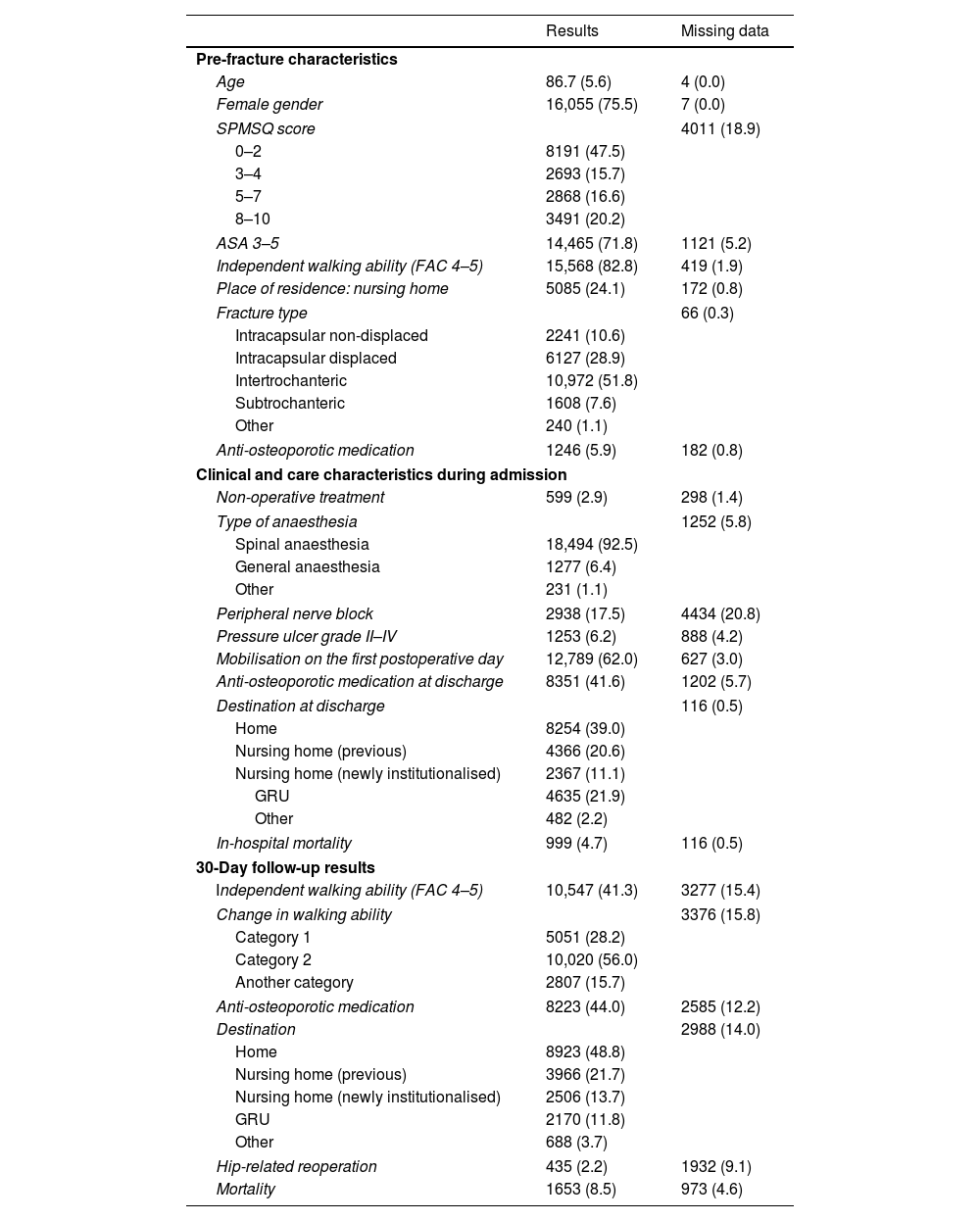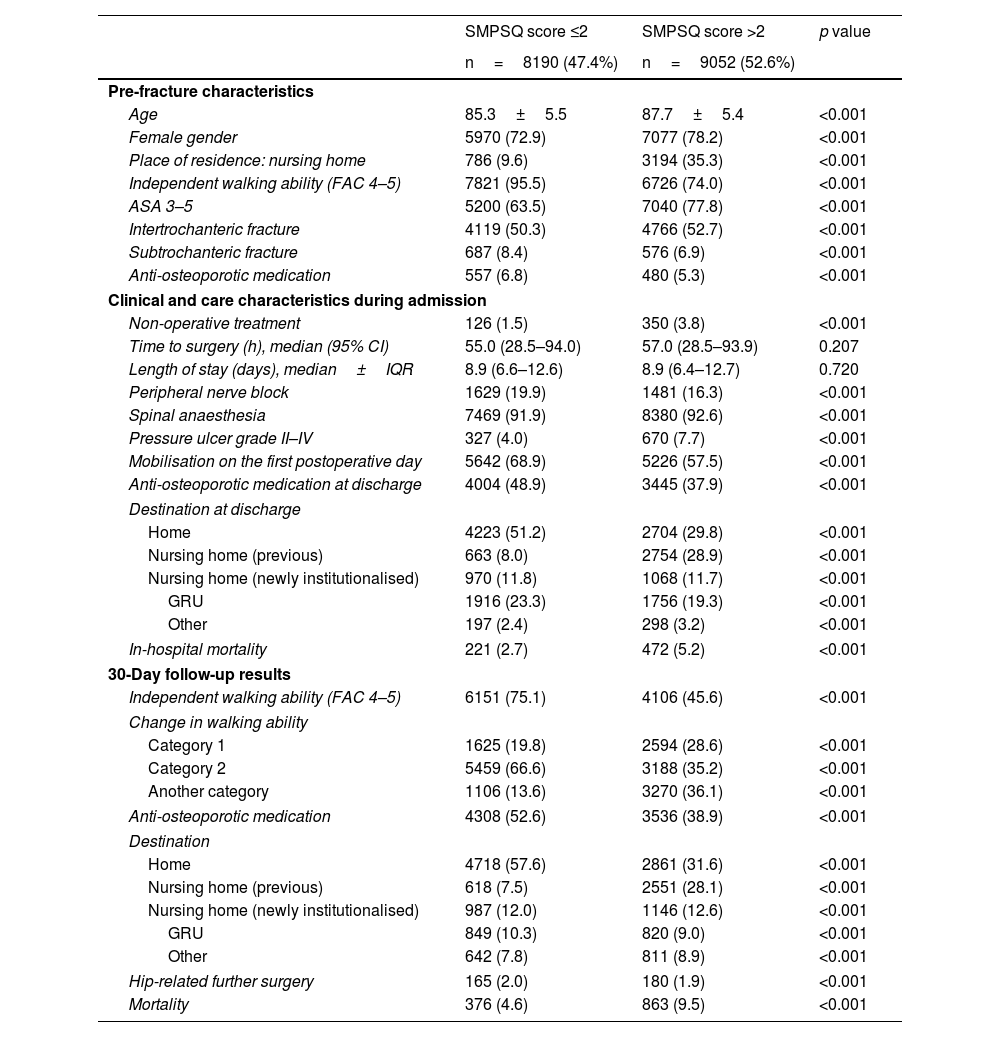To describe the differences according to mental status at admission on the care process and 30-day outcomes in hip fracture patients, mainly regarding the use of rehabilitation resources and anti-osteoporotic medication, by analysing data from the Spanish National Hip Fracture Registry (RNFC, “Registro Nacional de Fracturas de Cadera” in Spanish).
MethodsWe analysed prospectively collected data from a cohort of patients admitted participating in the Spanish National Hip Fracture Registry (RNFC) in 76 Spanish hospitals between 2017 and 2019. We classified participants using Short Portable Mental Status Questionnaire (SPMSQ), defining two groups: patients with ≤2 SPMSQ score and patients with >2 SPMSQ score.
ResultsOf 21,254 patients was recorded SPMSQ in 17,242 patients, 9052 were >2 SPMSQ score (52.6%). These were older (87.7 vs. 85.3 years; p<0.001), had worse mobility (no-independent walking ability 26.0% vs. 4.5%; p<0.001) and were more likely to be living in nursing homes (35.3% vs. 9.6%; p<0.001). They were more likely to be treated nonoperatively (3.8% vs. 1.5%; p>0.001), less early mobilisation (57.5% vs. 68.9%; p<0.001) and suffered higher in-hospital mortality (5.2% vs. 2.7%; p<0.001). At discharge, they received less anti-osteoporotic medication (37.9% vs. 48.9%; p<0.001) and returned home less often (29.8%% vs. 51.2%; p<0.001). One month after fracture, patients with >2 SPMSQ score had poorer mobility (no-independent walking ability 44.4% vs. 24.9%; p<0.001) and were newly institutionalised in a nursing home more (12.6% vs. 12.0%; p<0.001) and were more likely to die by one-month post-fracture (9.5% vs. 4.6%; p<0.001).
ConclusionRNFC patients with >2 SPMSQ score were more vulnerable and had poorer outcomes than patients with ≤2 SPMSQ score, suggesting that they need specialised care in-hospital and in the recovery phase.
Describir las diferencias al ingreso, durante el proceso asistencial y a los 30 días del alta, en el paciente con fractura de cadera según el estado cognitivo al ingreso, principalmente en el uso de recursos rehabilitadores y tratamiento antiosteoporótico, mediante el análisis de datos del Registro Nacional de Fractura de Cadera (RNFC).
MétodoAnalizamos los datos recogidos prospectivamente de la cohorte de pacientes que participaron en el RNFC en 76 hospitales españoles entre los años 2017 y 2019. Clasificamos a los participantes mediante el Short Portable Mental Status Questionnaire (SPMSQ), definiendo 2 grupos: pacientes con puntuación ≤2 SPMSQ y >2 SPMSQ.
ResultadosDe 21.254 pacientes se registró el SPMSQ, en 17.242 pacientes, 9.052 tuvieron una puntuación >2 SPMSQ (52,6%). Estos eran mayores (87,7 frente a 85,3 años; p<0,001), tenían peor movilidad (sin capacidad para caminar de forma independiente 26,0 frente al 4,5%; p<0,001) y tenían más probabilidades de vivir en residencia (35,3 frente al 9,6%); p<0,001). Tenían más probabilidades de recibir tratamiento conservador (3,8 frente al 1,5%; p>0,001), menor movilización temprana (57,5 frente al 68,9%; p<0,001) y sufrieron mayor mortalidad hospitalaria (5,2 frente al 2,7%; p<0,.001). Al alta, recibieron menos tratamiento antiosteoporótico (37,9 frente al 48,9%; p<0,001) y regresaron a domicilio con menor frecuencia (29,8 frente al 51,2%; p<0,001). Un mes después de la fractura, los pacientes con puntuación SPMSQ>2 tenían peor movilidad (sin capacidad para caminar de forma independiente 44,4 frente al 24,9%; p<0,001) y fueron institucionalizados recientemente en residencia con mayor frecuencia (12,6 frente al 12,0%; p<0,001), y tenían mayor probabilidad de fallecer al mes de la fractura (9,5 frente al 4,6%; p<0,001).
ConclusiónLos pacientes del RNFC con puntuación en el SPMSQ>2 fueron más vulnerables y tuvieron peores resultados que los pacientes con una puntuación en el SPMSQ≤2, lo que sugiere que necesitan atención especializada tanto en el hospital como en la fase de rehabilitación.









